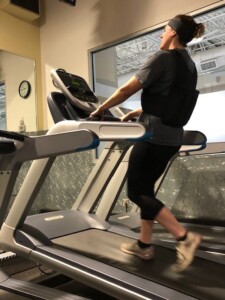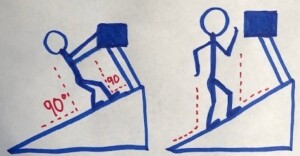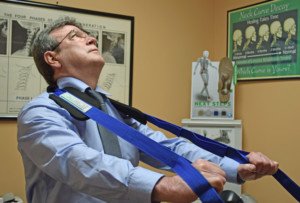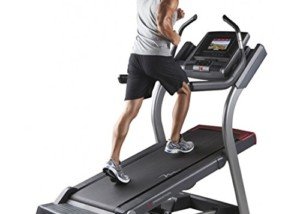
Are there any benefits or training effect if you death grip a treadmill while “walking” 5 mph at 15 percent incline?
First off, you’re setting your hips up for injury.
When I was a personal trainer at a major health club, my biggest pet peeve was the “grippers.”
I made it a point to inform two or three people every time I was there to remove their hands from the treadmill – and I gave them in-depth reasons why.
One day while walking on a treadmill to wind down from a strength workout, I was flabbergasted at the man on the machine next to mine.
• 15 percent incline
• 5.4 mph. Yes, 5.4 mph.
• Death grip, complete with hard yanking with each step.
• He wasn’t jogging; he was forcing himself to walk.
• His eyes were shut for most of this.
“This scenario creates poor body mechanics and disrupts the normal kinetic chain,” says Dr. Tom Carpenter, corrective exercise specialist, certified personal trainer and chiropractor, inventor of Stand Corrected™, a portable harness-like stretching tool that helps alleviate back, neck and shoulder pain.
“It displaces most of the load to the lower body, denying the mid-core muscles of engaging in order to assist in balancing the entire body during the gait mechanism,” explains Dr. Carpenter.
Because he was forcing a walk at over 5 mph while clutching the front bar of the treadmill and leaning way back, his hips were forcefully – and very unnaturally – over-rotating.
This unnatural, ballistic joint action puts him at risk for a repetitive stress injury in the hips.
But let’s suppose that never happens. He would still be setting his feet up for injury. Each step was slamming down on the belt in an unnatural way.
His entire motions from shoulders to feet were ridiculously unnatural and thus, there was no benefit to what he was doing.
Hanging hard to the treadmill, even at 15 percent and over 5 mph, will not produce a training effect that will carry over to real life.
In other words, if this is how he’s preparing for the hiking season, he’s in for a shocking surprise when he starts climbing hills – where there’s nothing to grip onto – and his low back starts killing him.

Holding on with straight arms makes the body tilt back AT THE SAME ANGLE AS THE INCLINE. Note the angular relationship of 90 degrees between the walker and the tread surface. This is the SAME angular relationship with a ZERO incline. The right figure is not holding on. This changes his body’s angular relationship to the tread surface, replicating the natural angle he’d be at if walking up a hill outdoors.
Incline Walking without Holding on Engages the Low Back Muscles
• The low back muscles (erector spinae) work to prevent you from falling backwards.
• This work is nullified if you hold on; your arms take over, freeing your low back from this important task.
• If your low back is used to being freed up from work in this fashion, then once you hit the hills outdoors—the real thing—your back will pay dearly for it.
Must all exercise be applicable to real life movement?
No. I myself do a few routines that have zero carryover to real life movement. For instance I do lateral crossover raises for deltoid work on a dual cable machine.
But this is for refinement of my “caps,” i.e., the sculpt of my deltoids.
Why do you think the man was on the treadmill at 15 percent incline and 5 mph?
• To isolate a muscle for sculpting
• To train for hiking
• To improve cardiovascular fitness
• To look ridiculous
I’ll bank on bullet 2 and/or 3. We already went over 2. But what about 3? Well certainly, his heart rate was elevated. In fact, he was sweating.
If you jar your body enough for 30 minutes, you’ll sweat, but some people sweat a lot more than others. The presence of sweat does not indicate efficacy of the exercise.
Furthermore, there is no need to put your hips and feet at risk for repetitive stress injuries in order to get a cardiovascular workout.
What to do if you want to exercise at 15 percent incline and 5 mph?
• Employ interval training rather than sustained (steady state) movement.
• Interval training would mean jacking the treadmill up to 5 mph for maybe 20, 30 or 45 seconds, at 15 percent incline, and jogging (no need to force a walk) this speed – WITHOUT HOLDING ON.
• After this brief burst (it may even be a minute or two full minutes, depending on your fitness), knock the speed down to a recovery-interval pace, perhaps 1 to 1.5 mph, while keeping the 15 percent incline.
• Or, you can also lower the incline if you want the recovery pace to be a little faster.
• After a few minutes of the recovery pace, return to the 15 percent, 5 mph setting.
• Do eight work intervals, without holding on, then warm down and you’re done!
• And all without imposing unnatural forces on your hip joints and feet.
• And all without looking absolutely absurd!
Think of how you’d do hill workouts outside. Would you hang onto anything? No.
There’s nothing to hold onto. So if you do incline workouts on a treadmill, why would you hold on?

Photo credit: Aleesia Forni









































